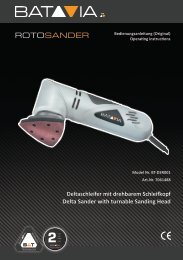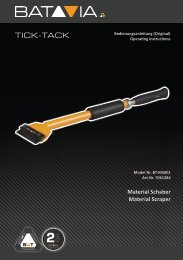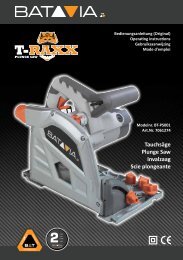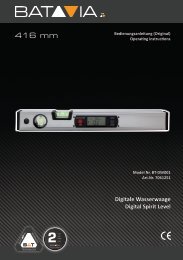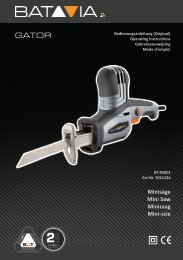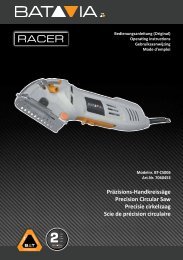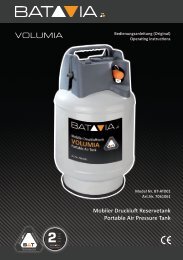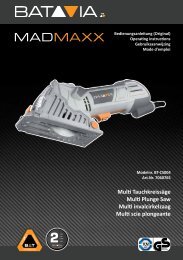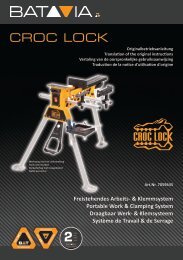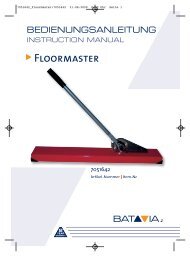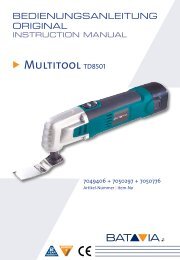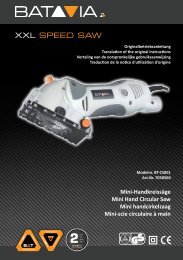Manual Racer Precision-Speed Saw
You also want an ePaper? Increase the reach of your titles
YUMPU automatically turns print PDFs into web optimized ePapers that Google loves.
EN<br />
c) Avoid the area in front of and behind a<br />
rotating cutting wheel. A kickback will send<br />
the electric power tool in the opposite direction<br />
to the movement of the grinding disc at the<br />
point where it jams.<br />
d) Work extremely carefully in the<br />
neighbourhood of corners, sharp edges<br />
etc. Prevent the tool insert from recoiling<br />
from the workpiece and jamming. The<br />
rotating tool insert bends at corners and sharp<br />
edges or if it rebounds and may jam itself. This<br />
causes a loss of control or kickback.<br />
e) Do not use any chainsaw or toothed saw<br />
blade, nor any segmented diamond disc,<br />
with slots wider than 10 mm. Such tool<br />
inserts frequently cause a kickback or loss of<br />
control of the electric power tool.<br />
f) Avoid jamming of the cutting wheel or too<br />
high a contact pressure. Do not make<br />
excessively deep cuts. An overload of the<br />
cutting wheel increases its stress and its<br />
susceptibility to tilting or jamming and, hence,<br />
increases the possibility of a kickback or break<br />
in the grinding wheel.<br />
g) If the cutting wheel becomes jammed or if<br />
you interrupt the work, switch the device<br />
off and keep it held gently until the disc<br />
has come to a standstill. Never attempt to<br />
remove a still-running cutting wheel from<br />
the cut, otherwise kickback may result.<br />
Find and remove the cause for the jamming.<br />
h) Do not switch on the electric power tool<br />
again, while it is still in the workpiece.<br />
Allow the cutting wheel to first reach its full<br />
rotation speed before carefully continuing<br />
the cut; otherwise, the disc may snag, jump<br />
out of the workpiece or cause a kickback.<br />
i) Provide support for large workpieces, to<br />
reduce the risk of a kickback through<br />
jamming of the cutting wheel. Large<br />
workpieces can bend under their own weight.<br />
The workpiece must be supported on both sides<br />
of the disc, as well as both in the neighbourhood<br />
of the separation cut and at the edges.<br />
j) Be especially careful when making "pocket<br />
cuts" in existing walls or other non-visible<br />
areas. The immersed cutting tool can cause a<br />
kickback when cutting into gas or water pipes,<br />
electric cables or other objects.<br />
2.7 SAFETY AND OPERATING INSTRUCTIONS<br />
FOR DIAMOND GRINDING WHEELS<br />
Use<br />
Only use the cut off grinding disc for cut off<br />
grinding and not for rough grinding! Only use the<br />
cut off grinding discs for the materials indicated<br />
and not for any other materials. Risk of injury!<br />
Cutting and cooling!<br />
General Information<br />
This tool insert is fragile, therefore extreme care<br />
is required when handling it. The use of damaged<br />
and incorrectly tensioned or installed tool inserts<br />
is dangerous and can result in serious injury.<br />
Handling and storage<br />
Tool inserts must be carefully handled and<br />
transported. Tool inserts should be stored in such<br />
a way that they are not exposed to any<br />
mechanical damage or damaging environmental<br />
influences.<br />
To avoid damage, remove the tool insert before<br />
transporting an electric power tool.<br />
Selection and safe and proper use<br />
Pay attention to the data on the label or on the<br />
tool insert, such as the restrictions on use, safety<br />
instructions or other advice. Do not alter the<br />
characteristic direction of motion of the tool insert.<br />
If there is ambiguity over the selection of tool<br />
inserts, contact the manufacturer or a specialist.<br />
Adhere to the permissible rotation speeds for the<br />
tool insert and the electric power tool.<br />
Before use<br />
Tool inserts must be given a visual inspection<br />
before each start-up. Do not use damaged tool<br />
inserts. Secure the piece to be worked on.<br />
Inserting and changing<br />
Tighten the tool inserts in accordance with their<br />
instructions and those of the electric power tool's<br />
manufacturer. The tightening of tool inserts should<br />
only be undertaken by qualified persons. After<br />
each tightening, carry out a test run for a suitable<br />
length of time, during which the characteristic<br />
maximum working speed of the tool insert may<br />
not be exceeded.<br />
Always tighten tool inserts without introducing any<br />
out-of-roundness.<br />
23




